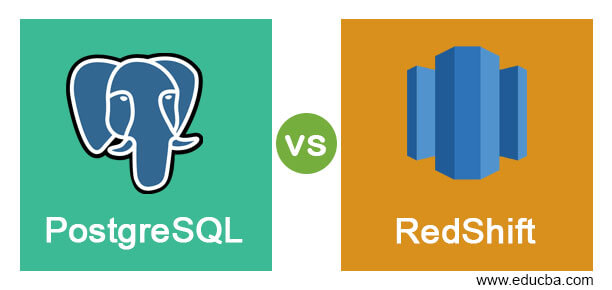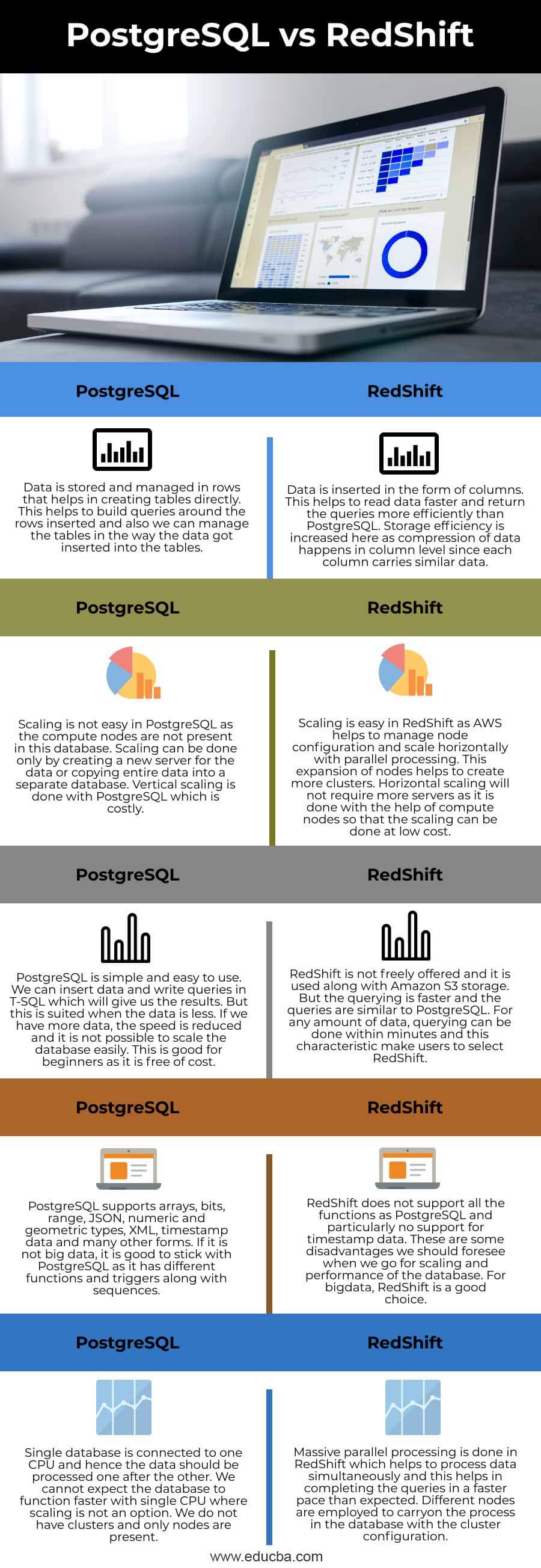Difference Between PostgreSQL vs RedShift
The following article provides an outline for PostgreSQL vs RedShift. PostgreSQL is an open-source RDBMS system with SQL support and extensions that use a variant of SQL called T-SQL to enable more advanced procedures in their queries. This helps store and scale any complex or simple workloads in its system. It can store data for any application. Amazon offers a data warehouse product called RedShift, which achieves reduced execution time through parallel processing and compression. RedShift is compatible with PostgreSQL, and we can run T-SQL queries in RedShift to get advanced queries. This is mostly used for analytics & reporting.
Head to Head Comparison Between PostgreSQL vs RedShift (Infographics)
Below are the top 5 differences between PostgreSQL vs RedShift:
Key Difference Between PostgreSQL vs RedShift
Let us discuss some of the major key differences between PostgreSQL vs RedShift. Additionally, we will explore the advantages of migrating from Postgres to Redshift as it presents compelling insights into enhanced data warehousing capabilities.
- RedShift is more used in analytics; hence, the column database helps process the data faster.RedShift does not use index keys; instead, they are replaced by SORT and DIST keys. Foreign keys or any other constraints are absent hence, it will take time to sort out the values in the RedShift database. We use a cluster here to manage billions of records in a single shard. PostgreSQL is suitable for simple queries and less data. The nodes store the data, and there are no clusters present in this context. We have indexes, a foreign key concept in PostgreSQL. Performance for analytics is best in RedShift than in PostgreSQL.
- Both RedShift and PostgreSQL actively utilize SQL, although the application of SQL commands varies between the two. In RedShift, we actively perform distributions and sort algorithms using CREATE TABLE, but we should note that inheritance and partitioning are not supported. We can insert and update the table, but it does not allow us to create new tables with the insert command. With Create command, we can create tables, sorting, inheritance, and partitioning in PostgreSQL. We can insert and delete tables along with PostgreSQL’s ‘WITH’ clause.
- RedShift actively follows different distribution styles to accelerate the insertion of data into the database. In RedShift, key distribution actively involves cross-checking the data with the key values in the column and placing it in the corresponding columns. The values are actively compared with other columns, and the columns are grouped together if there are matching values. This helps users to locate the data quickly. PostgreSQL does not follow any specific distribution styles or patterns. Instead, we actively need to locate columns carrying similar data using queries.
- The use of VACUUM is different in both databases. PostgreSQL helps to get back the space in the database with the VACUUM command whereas RedShift sorts all rows as well along with reclaiming space in the database.
- A leader node is present in the database cluster to manage the data insertion and management into the database. The work actively distributes among different worker nodes, ensuring efficient management of data that can be queried whenever needed. We do not have any leader nodes or worker nodes in PostgreSQL, as it works with a single node database.
Comparison Table of PostgreSQL vs RedShift
Let’s discuss the top comparison between PostgreSQL vs RedShift:
| PostgreSQL | RedShift |
| Data is stored and managed in rows that help in creating tables directly. This helps to build queries around the rows inserted, and also we can manage the tables in the way the data got inserted into the tables. | Data is inserted in the form of columns. This helps to read data faster and return the queries more efficiently than PostgreSQL. Storage efficiency actively increases as data compression occurs at the column level, considering that each column contains similar data. |
| Scaling is not easy in PostgreSQL as the compute nodes are not present in this database. To achieve scaling, you must actively create a new server for the data or actively copy the entire data into a separate database. With PostgreSQL, vertical scaling is actively performed, but it can be costly. | Scaling is easy in RedShift as AWS helps to manage node configuration and scale horizontally with parallel processing. This expansion of nodes helps to create more clusters. Horizontal scaling does not necessitate additional servers, as it is accomplished through compute nodes, resulting in cost-effective scaling. |
| PostgreSQL is simple and easy to use. We can insert data and write queries in T-SQL, giving us the results. But this is suited when the data is less. If we have more data, the speed is reduced, and it is impossible to scale the database easily. This is good for beginners as it is free of cost. | RedShift is not freely available and requires the use of Amazon S3 storage in conjunction. However, it offers faster querying capabilities, and the query syntax is similar to PostgreSQL. Users actively select RedShift due to its capability to perform queries on any amount of data within minutes. |
| PostgreSQL supports arrays, bits, range, JSON, numeric and geometric types, XML, timestamp data, and many other forms. If it is not big data, it is good to stick with PostgreSQL as it has different functions, triggers, and sequences. | RedShift does not support all the functions as PostgreSQL and particularly no support for timestamp data. We should foresee some disadvantages when scaling and performing the database. For bigdata, RedShift is a good choice. |
| A single database is connected to one CPU, so the data should be processed one after the other. We cannot expect the database to function faster with a single CPU where scaling is not an option. We do not have clusters, and only nodes are present. | RedShift actively performs massive parallel processing, enabling simultaneous processing of data. This capability helps in completing queries at a faster pace than expected. The cluster configuration in the database employs different nodes to carry out the processing. |
Conclusion
When the amount of data is in terabytes and if there is no increase in data in the near future, we can go with PostgreSQL. If it is bigdata and analytical queries are always running, RedShift is a good choice. Also, if we have a database already with AWS, PostgreSQL will not be good as it will cost more than the expected amount.
Recommended Articles
We hope that this EDUCBA information on “PostgreSQL vs RedShift” was beneficial to you. You can view EDUCBA’s recommended articles for more information.




